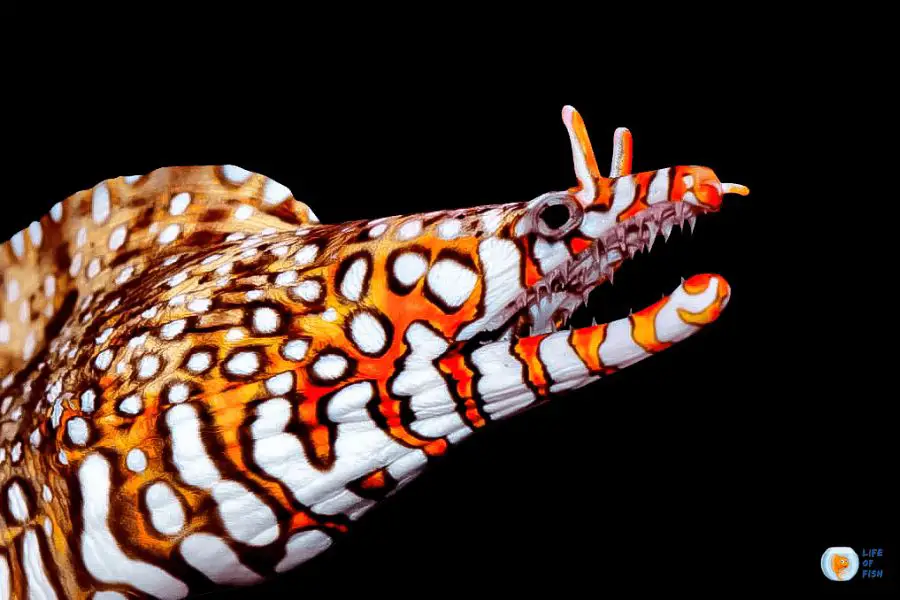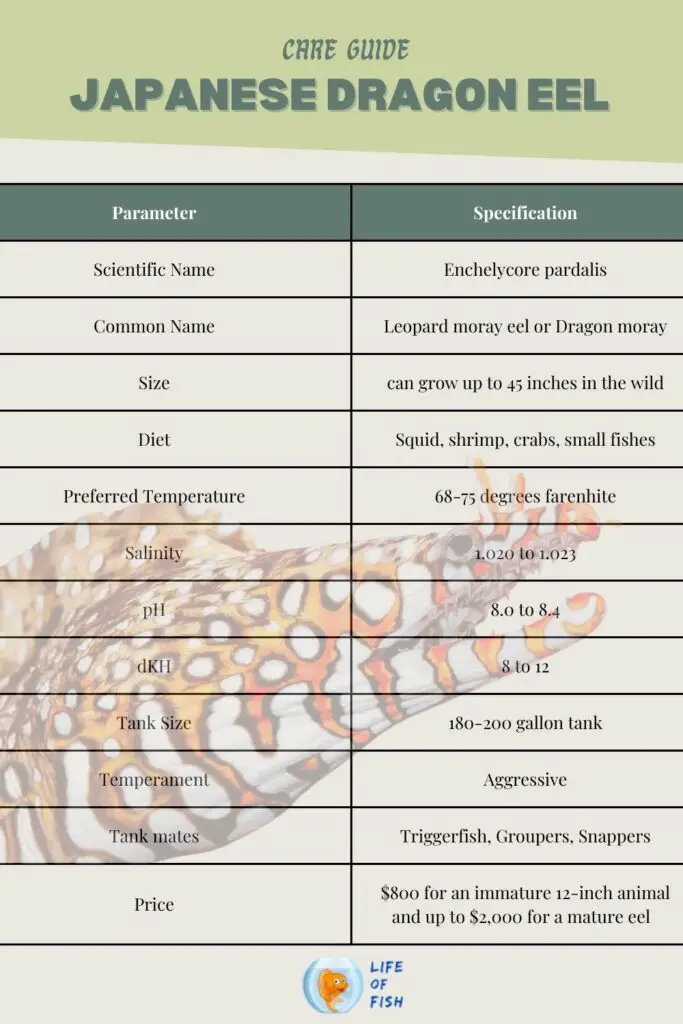The Japanese Dragon Eel, also known as the Dragon Moray Eel (Enchelycore pardalis), is a fascinating creature. And they captivate the imagination with their unique appearance and mysterious nature. With its long, slender body, intricate pattern, and snakelike movements, this eel has become a subject of intrigue for both marine enthusiasts and folklore enthusiasts alike.
In this article, we will delve into the world of the Japanese Dragon Eel, exploring its physical characteristics, habitat, behavior, cultural significance, and more.

Physical Appearance of Japanese Dragon Eel
Jump To
The Japanese Dragon Eel boasts a striking physical appearance that sets it apart from other marine species. With an elongated body reaching lengths of up to 1.2 meters (4 feet), it glides through the ocean depths with grace and agility. Its body is adorned with an intricate pattern of black or dark brown spots on a light tan or cream-colored background. It resembles the scales of a mythical dragon. These unique markings make it a true spectacle to behold.
One of the most distinctive features of the Japanese Dragon Eel is its long, continuous dorsal fin. And it stretches along its entire back, from the head to the tip of the tail. This fin undulates gracefully, resembling the movements of a dragon in flight, further adding to the eel’s fantastical allure. Its head is relatively small and adorned with sharp teeth, perfectly adapted for capturing prey.

Natural Habitat of Japanese Dragon Eel
You can find Japanese Dragon Eels in the western Pacific Ocean, particularly in the waters surrounding Japan, hence their name. They inhabit rocky reef areas and coral formations. It often resides in crevices and caves at depths ranging from 20 to 200 meters (65 to 650 feet). These eels prefer areas with strong currents, as they aid in the oxygenation of their gills.
The geographical range of the Japanese Dragon Eel extends beyond Japan, encompassing other regions such as Taiwan and the Philippines. They are elusive creatures, rarely encountered by humans due to their deep-sea dwelling preferences.
Behavior and Feeding Habits of Japanese Dragon Eel
The Japanese Dragon Eel is a nocturnal predator, hunting primarily during the cover of darkness. Its elongated body allows it to navigate through narrow crevices and reach hidden prey with ease. These eels are voracious carnivores, feeding on a diet consisting mainly of fish and crustaceans. Using their sharp teeth and powerful jaws, they capture their prey swiftly and efficiently.
During the day, Japanese Dragon Eels hide in their preferred habitats, often remaining concealed within crevices or coral formations. They display a solitary nature, rarely interacting with other individuals of their kind, except during the breeding season.
Reproduction and Life Cycle
The reproductive process of Japanese Dragon Eels is still largely unknown, given the challenges of studying their behavior in the deep-sea environment. During spawning, they release eggs and sperm to the water column for fertilization. Due to lack of researches, we know very little about their mating rituals or parental care.
The newly hatched Japanese Dragon Eels are thought to possess a leptocephalus larval stage, where they appear as transparent, leaf-shaped organisms. During this stage, they drift with ocean currents, undergoing various metamorphoses until they eventually settle in the reef or rocky areas where they will spend their adult lives.
Role in the Ecosystem
Japanese Dragon Eels play a vital role in the marine ecosystem, serving as both predators and prey. As predators, they help control the population of smaller fish and crustaceans, contributing to the balance of the food chain. Their presence in reef and rocky areas also provides shelter and refuge for other marine organisms, further enhancing the biodiversity of these habitats.

Conservation Status
Due to the deep-sea nature of the Japanese Dragon Eel’s habitat and its elusive behavior, assessing its conservation status accurately is challenging. Currently, there is limited data available on their population size and trends. However, like many marine species, they face potential threats from habitat destruction, overfishing, and pollution. It is crucial to promote sustainable fishing practices and protect their habitats to ensure the long-term survival of these enigmatic creatures.
Cultural Significance
In Japanese folklore, the Dragon Eel holds a significant place. It is often associated with mythical creatures and legendary tales. Some stories depict the eel as a guardian or protector, while others emphasize its mystical properties. Its presence in local traditions and beliefs has contributed to its cultural significance, making it a symbol of strength, wisdom, and longevity.
Conclusion
The Japanese Dragon Eel is a captivating marine creature that continues to enthrall researchers and enthusiasts alike. Its unique physical appearance, elusive nature, and cultural significance make it a subject of wonder and admiration. By understanding and appreciating these enigmatic eels, we can foster a greater appreciation for the diverse and awe-inspiring wonders of the underwater world.
FAQs
1. Are Japanese Dragon Eels dangerous to humans?
Japanese Dragon Eels are not considered dangerous to humans unless provoked or handled improperly. Like most eels, they may bite if they feel threatened, but their bites are generally not venomous.
2. Can Japanese Dragon Eels be kept as pets in aquariums?
Due to their specialized needs, including deep-sea habitats and large swimming spaces, Japanese Dragon Eels are not suitable for home aquariums. They require specialized care and are best appreciated in their natural environment.
3. Do Japanese Dragon Eels breathe air like some other eel species?
No, Japanese Dragon Eels do not possess the ability to breathe air. They rely solely on gills to extract oxygen from the water.
4. How long can Japanese Dragon Eels grow?
Japanese Dragon Eels can reach lengths of up to 1.2 meters (4 feet) when fully grown. However, their growth rate and maximum size can vary depending on environmental factors and food availability.
5. Are Japanese Dragon Eels related to actual dragons?
No, Japanese Dragon Eels are not related to mythical dragons. The association with dragons arises from their physical appearance, resembling the scales and long body often associated with dragon depictions in folklore and mythology.
Now that you’ve learned about the captivating Japanese Dragon Eel, take a moment to appreciate the wonders of the deep sea and the fascinating creatures that call it home.
